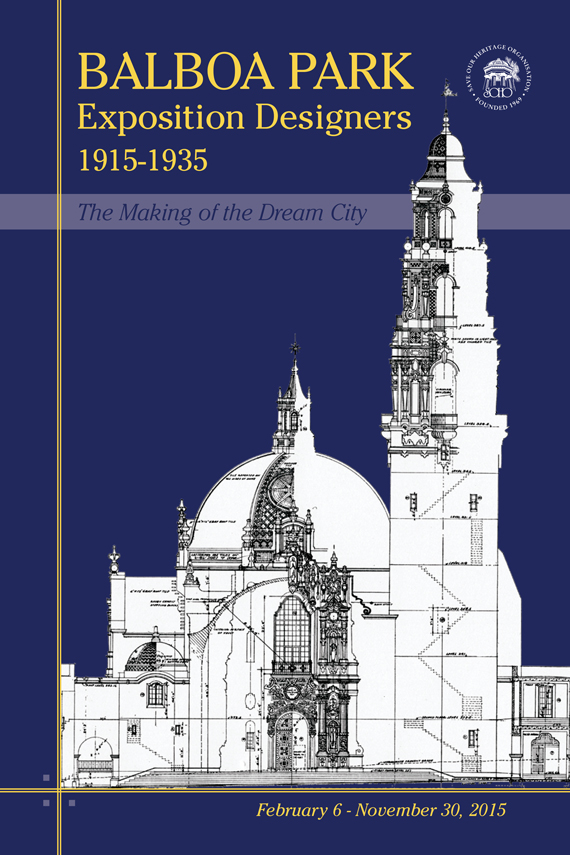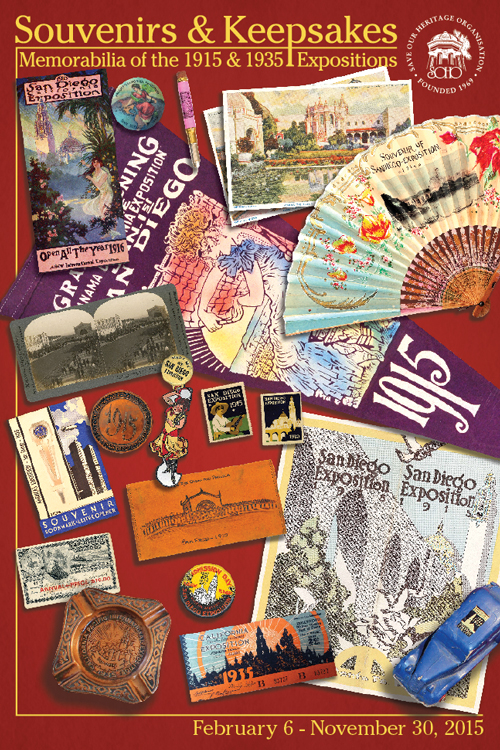SAN DIEGO - Save Our Heritage Organisation will present two engaging Balboa Park history exhibitions Feb. 7-Nov. 30 at the Marston House Museum & Gardens in celebration of the 1915 Panama-California Exposition Centennial. These rich and varied displays are Souvenirs & Keepsakes: Memorabilia of the 1915 & 1935 Expositions and Balboa Park Exposition Designers 1915-1935: The Making of the Dream City. Tickets for the opening reception, Feb. 6 from 6pm to 8:30pm, may be purchased from SOHO, the region's leading historic preservation group HERE.
 The park's high design by the renowned architects Bertram Grosvenor Goodhue and Richard Requa for the Balboa Park expositions of one exhibition will meet an abundant selection of rarely seen pop culture souvenirs from two outstanding private collections. For the first time, life-long collector Richard Miller is lending dozens of important selections from the thousands of wide-ranging Expo souvenirs he owns. David Marshall, an architect who began collecting historic postcards of San Diego buildings to assist him in his work and then expanded his hunt to the Expositions, has previously exhibited only a fraction of his vast collection. (The collectors, formidable eBay-auction rivals, will finally meet in person at SOHO's Feb. 6 reception.)
The park's high design by the renowned architects Bertram Grosvenor Goodhue and Richard Requa for the Balboa Park expositions of one exhibition will meet an abundant selection of rarely seen pop culture souvenirs from two outstanding private collections. For the first time, life-long collector Richard Miller is lending dozens of important selections from the thousands of wide-ranging Expo souvenirs he owns. David Marshall, an architect who began collecting historic postcards of San Diego buildings to assist him in his work and then expanded his hunt to the Expositions, has previously exhibited only a fraction of his vast collection. (The collectors, formidable eBay-auction rivals, will finally meet in person at SOHO's Feb. 6 reception.)
"These exhibitions are just the start of SOHO's year-long Centennial celebration of tours, lectures, publications and art shows, all of which are designed to present and preserve Balboa Park's Exposition history in meaningful ways," said Alana Coons, SOHO's Education and Communictions Director. "We hope our Centennial exhibitions will capture people's imaginations as well as add to their knowledge of San Diego history."
 Souvenirs & Keepsakes: Memorabilia of the 1915 & 1935 Expositions is bursting with pride, promotion, novelty and humor. Both San Diego Expositions were held to market international trade, tourism and land sales, themes reflected in this array of memorabilia in revealing ways. The souvenirs on view at the Marston House range from trinkets to fine art.
Souvenirs & Keepsakes: Memorabilia of the 1915 & 1935 Expositions is bursting with pride, promotion, novelty and humor. Both San Diego Expositions were held to market international trade, tourism and land sales, themes reflected in this array of memorabilia in revealing ways. The souvenirs on view at the Marston House range from trinkets to fine art.
One of Marshall's favorite objects in his collection is a hollowed-out walnut shell that, when opened, presents a tiny, accordion-folded, pictorial guide to the 1935 Exposition tucked inside. One of his rarest items is a guidebook to Zoro Gardens, the controversial 1935 resident nudist colony that charged admission to a "Sun God" skit. Miller's favorites include a small, souvenir sack from a Pala mine that was partly recreated in the park for 1915 visitors to explore. Sealed since the expo, the bag contained Pala gem samples, including tourmaline.
Whether carefully preserved or in use for generations, many Expo keepsakes offer insights into San Diego's cultural and economic life, separated by two decades. Fine goods, such as silk scarves, complete sets of china and sterling silver jewelry, were sold in 1915, whereas the 1935, Depression-era offerings were more limited in quality and materials, according to Miller, a San Diego native. "The first expo promoted the region's early Spanish heritage, while connections to Mexico were more evident in 1935, in part, due to prohibition laws in the U.S.," he said.
Seeing so many Exposition souvenirs together presents a rare opportunity to uncover dozens of stories about people in a specific time, place and culture, as well as registering an overall impact. "With such a large group, you see the context," Marshall said. "It's like the pieces of a puzzle: The more pieces you have, the better the picture you have."
In conjunction with this historic exhibition, SOHO obtained exclusive rights from the collectors and tapped its own archives to reproduce or adapt some of the best and liveliest historic mementos for purchase today. A freshly minted, limited edition 1915 medallion, full-color posters, pinback buttons and mirrors, a set of 1935 Modeltown sales cards, silk handkerchiefs re-imagined as lens cloths, notebooks, puzzles, and even jewelry will allow visitors to take home 21st-century Expo memories and perhaps start souvenir collections of their own.
"SOHO is known for carrying historically relevant, quality items in our museum shops," Coons said. "You won't see most of these attractive, well-made Centennial souvenirs anywhere else, with a few exceptions of items shared with the Balboa Park Conservancy Visitors Center and the San Diego History Center.One item should please today's craft beer lovers, new beer serving trays advertising one of the winning 1915 Expo's beer competitors.
SOHO has also commissioned original, limited-edition artwork for special purchases. Ceramic artist Stephani Stephensonhas created a handcrafted tile design portraying Cabrillo Bridge and the 1915 western entrance to Balboa Park in an edition of 100.
These and other carefully selected keepsakes linked to Exposition history are available now at the Marston House Museum Shop, other SOHO museum shops at historic sites throughout San Diego County: Whaley House Museum Shop, Santa Ysabel Store, and Warner-Carrillo Ranch House Museum Shop; and in March by mail through SOHO's web site, www.sohosandiego.org.
In addition, each of SOHO's new exhibitions will be accompanied by an illustrated catalog.
Unlike the boisterous souvenirs exhibition, Balboa Park Exposition Designers 1915-1935: The Making of the Dream City unfolds in orderly, chronological fashion as it spotlights the talents and achievements of architects, artists and designers who shaped Balboa Park during the 20th-century. Curated with the San Diego American Institute of Architects Preservation Committee and other design experts, this display presents about 20 designers' biographies and their work for both expositions.
Original architectural drawings, sketches and period photographs will illustrate both expositions, so as not to interrupt the sweep of design history that produced the park we know today. In some cases, all that remains of the designs are drawings and photographs, so visitors may see what has been lost. The exhibition also sets the record straight about Kate Sessions, the nursery owner and horticulturalist now known as the "Mother of Balboa Park," whose exposition contributions have been misunderstood.
The famed, well-traveled Goodhue envisioned the 1915 exposition grounds as a "dream city" to be built in his ornate, fantasy version of the Spanish Colonial Revival style, complete with walled gardens, fountains, plazas and arcades. This Spanish-Mexican-Baroque wonderland created a romantic, stunningly beautiful environment that evoked San Diego's Spanish heritage; the evocative style soon spread across the nation.
Some designers veered a bit from Goodhue's holistic vision without disrupting it. Frank P. Allen, Jr., an architect-engineer-contractor and a Spanish-American War veteran, co-designed Cabrillo Bridge after studying Roman aqueducts. Self-taught architect Harrison Albright, who benefitted from the patronage of millionaire brothers, designed the Italianate Spreckels Organ Pavilion. And Isaac Rapp, an architect working out of Santa Fe, N.M. and Trinidad, designed the 1915 Exposition's New Mexico Building (now the Balboa Park Club) in the Pueblo Revival or Santa Fe Style he originated back home.
Two decades later, architects worked under the direction of the respected San Diego architect Richard Requa, an authority on Spanish vernacular architecture. He instructed the designers of the 1935 Exposition buildings and attractions to pay homage to ancient and modern American architectural styles, from Pueblo and Mayan to Art Deco and Streamline Moderne. Juan Larrinaga, fresh from the celluloid chills he created in Hollywood for King Kong, added a scenic designer's flourish to new or remodeled park buildings. Another specialist whose enduring work crops up throughout the exposition grounds is Chauncy Irving Jerabek, an expert plant propagator known as "The San Diego Tree Man."
To complement the two exhibitions, SOHO's opening weekend includes tours, and a speaker series. Other centennial events have been planned throughout 2015. For information on visiting the Marston House Museum & Gardens, viewing the exhibitions and SOHO's 2015 schedule of events, visit www.sohosandiego.org. Click on the Balboa Park icon labeled "San Diego Exposition Centennial 2015." Or call (619) 297-9327.